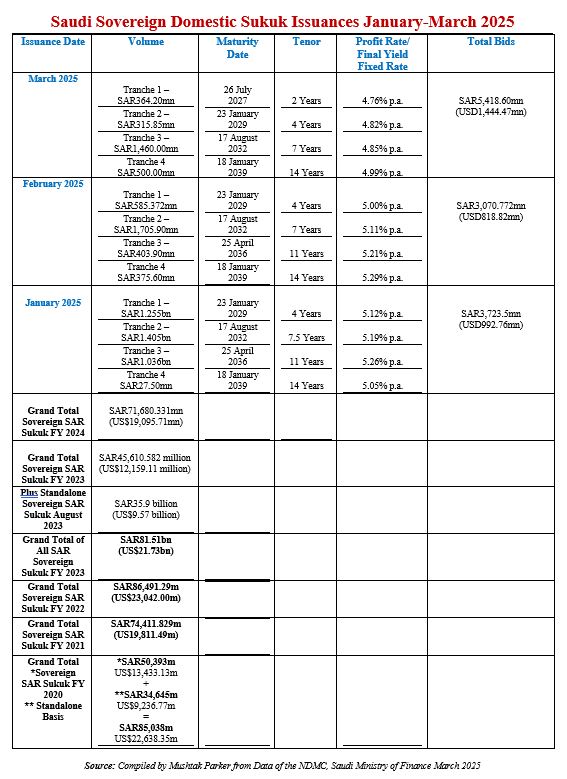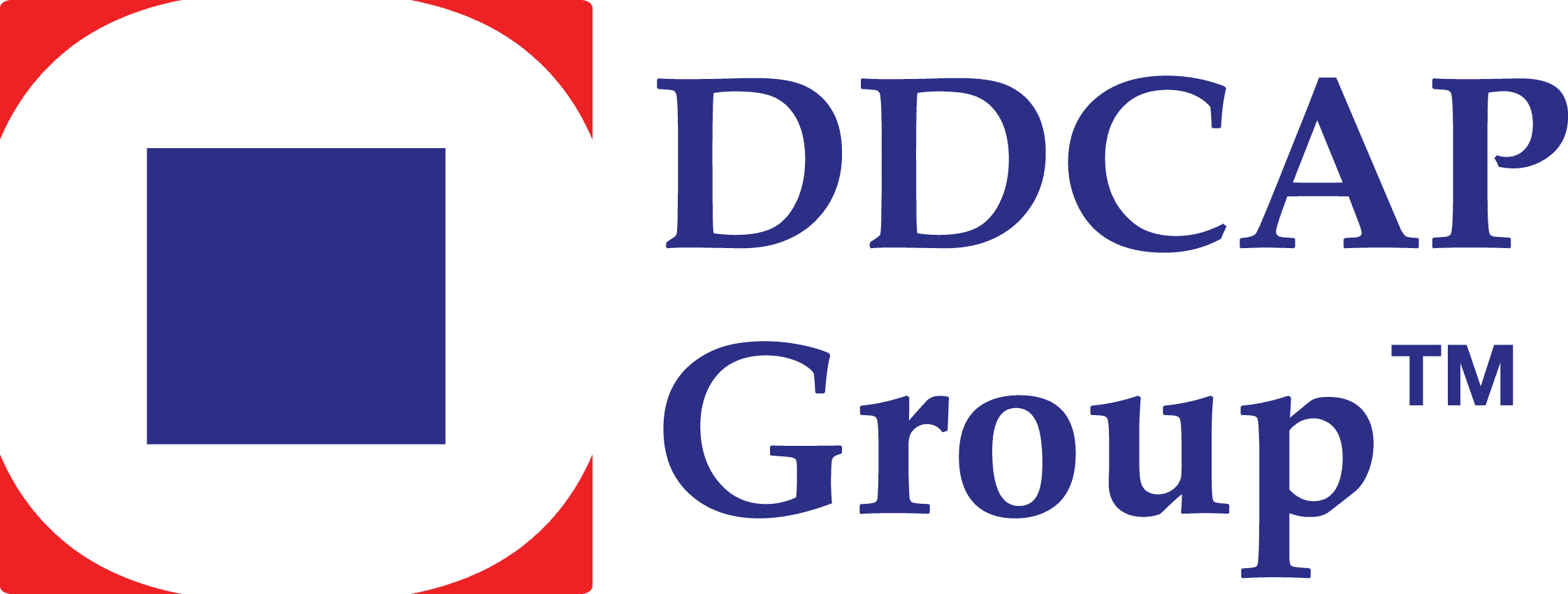NDMC Sustains Momentum of Saudi Riyal-denominated Market with a 4-Tranche Sovereign Sukuk Issuance Totalling SAR2.64bn (USD703.78mn) in March 2025 bringing the Q1 2025 Total to SAR9.43bn (USD2.52bn)
The National Debt Management Centre (NDMC) of the Saudi Ministry of Finance (MoF) continued its monthly Sukuk issuance momentum in March 2025 with a four-tranche aggregate issuance of SAR2,640.05mn (USD703.78mn) on 20 March 2025. This compared to the February 2025 Sukuk issuance which raised SAR3,070.772mn (USD818.82mn).
Saudi Arabia is ahead in tapping the domestic sovereign Sukuk market for manifold reasons including an established issuance infrastructure complete with a government policy framework under its ‘Fiscal Balance Programme and Financial Sector Development Programme, whose objectives are to add to a diversified public debt fund raising strategy and to the development of the Saudi Sukuk and Islamic Capital Market.
Moody’s Investors Service in an Islamic finance sector report published in early March stressed that demand for Islamic finance will continue to rise, as strong economic activity in the Gulf Cooperation Council (GCC) and Southeast Asia is supported by diversification agendas, investment inflows and population growth. Saudi Arabia remains the largest Islamic finance market, followed by Malaysia and the United Arab Emirates.
A few weeks earlier in February, Fitch Ratings in commentary anticipated the continuation of robust activity in Saudi Arabia’s debt capital market (DCM) in 2025, driven by Vision 2030 initiatives, deficit funding needs, economic diversification, maturing obligations, and ongoing reforms.
“Falling oil prices (2025F: USD70/barrel; 2026F: USD65) should increase funding requirements. In 2024, Saudi Arabia became the largest dollar debt issuer in emerging markets outside China, the largest DCM in the GCC, and the largest dollar Sukuk issuer globally. Almost all Saudi riyal issuance and ESG issuance in 2024 were in Sukuk Format,” said Bashar Al Natoor, Global Head of Islamic Finance at Fitch Ratings.
He expects the active DCM in Saudi Arabia to continue in 2025, following a strong start and growing issuance pipeline. “The DCM is likely to cross USD500 billion as soon as end-2025. Ambitious government projects under Vision 2030, deficit funding, diversification efforts, upcoming maturities, and ongoing reforms should drive DCM activity,” he added.
The Saudi DCM grew 20% year-over-year (end-2024: USD432.5bn outstanding), with a Sukuk majority (63%), mostly dollars (50%) and riyal (48.3%) issues. ESG debt remains a vital funding tool, with USD18.6bn outstanding, accounting for 9% of the dollar DCM.
Saudi banks have increased international DCM activities since 2020, aligning with their growth strategies and foreign-currency needs, while corporates are expected to broaden their funding sources beyond bank loans. Just under 85% of Sukuk are rated ‘A+’.
The March 2025 Saudi sovereign domestic Sukuk issuance of an aggregate SAR2,640.05mn (USD703.78mn) comprised:
i) A 2 -Year Tranche of 20mn (USD97.09mn) priced at a yield of 4.76% p.a. maturing on 26 July 2027.
ii) A 4 -Year Tranche of SAR315.85mn (USD84.20mn) priced at a yield of 4.82% p.a. maturing on 23 January 2029.
iii) A 7-Year Tranche of SAR1,460.00mn (USD389.20mn) priced at a yield of 4.85% p.a. maturing on 17 August 2032.
iv) A 14-Year Tranche of SAR500.00mn (USD133.29mn) priced at a yield of 4.99% p.a. maturing on 18 January 2039.
Total bids for the 4-tranche transaction on 20 March 2025 amounted to SAR5,418.60mn (USD1,444.47mn).
The NDMC started the year 2025 with a four-tranche auction on 23 January 2025 which raised an aggregated SAR3,723.5mn (USD992.76mn). It continued its proactive sovereign Sukuk issuance momentum in the Saudi riyal-denominated domestic market in February 2025 with a 4-tranche transaction aggregating SAR3,070.772mn (USD818.82mn).
With the March 2025 auction which raised SAR2,640.05mn (USD703.78mn), the Kingdom has raised an aggregate SAR9,434.322mn (USD2,515.36mn) for the first Quarter of 2025 through Saudi riyal-denominated sovereign Sukuk issuances.
The NDMC finished the year 2024 with a flourish of activities resulting in an auction on 24 December 2024 amounting to SAR11,598.081mn (USD3,087.44mn) – its 12th consecutive monthly auctions of the year under its published issuance calendar and the NDMC’s SAR Sukuk Issuance Programme.
The Programme raised a staggering SAR71,680.33mn (USD19,095.71mn) in 2024; SAR45,610.582mn (USD12,159.11mn) in 2023 supplemented by an additional SAR35.9bn (USD9.57bn) through a standalone local currency Sukuk, bringing the total SAR-denominated Sukuk to SAR81.51bn in 2023; SAR86,491.29m (USD23,042.00mn) in 2022; SAR74,411.829mn (USD19,811.49mn) in 2021; and SAR50,393m (USD13,433.13m) in 2020 supplemented by an additional SAR34,645mn (USD9,236.77mn) through a standalone local currency Sukuk, bringing the total to SAR-denominated Sukuk to SAR85,038mn (US$22,638.35mn) in 2020. These pertain to local currency Sukuk issuances and do not include the NDMC’s forays into the international Sukuk market and syndicated Murabaha markets.
The NDMC Sukuk are all issued under the unlimited Saudi Arabian Government SAR-denominated Sukuk Programme, which focuses on fixed-rate instruments “to hedge against risks of potential interest rate fluctuations.”

These issuances, confirmed the NDMC, will continue in accordance with the approved 2025 Annual Borrowing Plan, to consider additional funding activities subject to market conditions and through available funding channels locally or internationally.
This is to ensure the Kingdom’s continuous presence in debt markets and manage the debt repayments for the coming years while considering market movements and the government debt portfolio risk management.
The NDMC says it is committed to ensuring the Kingdom’s sustainable access to various debt markets to issue sovereign debt instruments at fair prices while maintaining prudent risk levels. To achieve this objective, it will continue to diversify financing channels throughout 2025. This diversification will include expanding financing through export credit agencies (ECAs), financing infrastructure projects, and exploring tapping into new markets in new currencies. These initiatives aim to expand the investor base and enhance the Kingdom’s access to global capital markets.
In January 2025, the Saudi Ministry of Investment’s updated investment rules also came into effect, which according to the NDMC will make it easier for foreign investors to invest in the Kingdom to attract more international investment by streamlining the process and creating a more investor-friendly environment. The ministry highlighted that the updated regulations would eliminate the need for many licenses and prior approvals, as well as significantly reduce paperwork and bureaucratic hurdles.
However, according to Fitch Ratings, foreign investors made up just 4.5% of the investor base of Saudi local government issuances in 2024. Greater inclusion in global indices, it stressed, could bolster demand.
In this respect, the NDMC continues to work on attracting new capital, and more international financial institutions in addition to selected local banks to take part in the Primary Dealers Program, to capitalize on the debt instruments arranged by the NDMC. Already, BNP Paribas, Citigroup, Goldman Sachs, J.P. Morgan, and Standard Chartered Bank have signed up as new primary dealers in the government’s local debt instruments. They join five local institutions, namely Saudi National Bank, Saudi British Bank (SABB), Al Jazira Bank, Alinma Bank, and Al Rajhi Bank, already in the NDMC’s Primary Dealers Programme.
